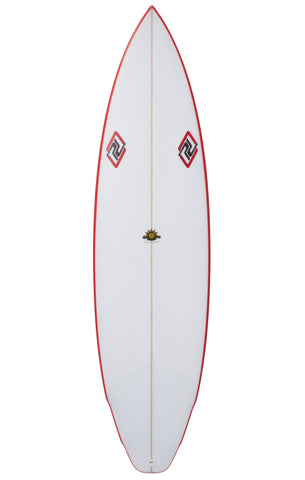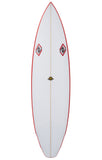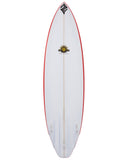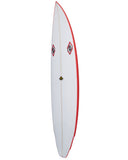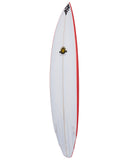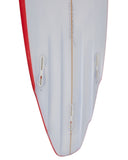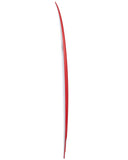There may be many that do not remember or know of the “Little General” but regardless he was the flag bearer through a period during the 80’s where channel bottoms were totally in favour. We have them back now as a standard today, but mostly in hybrid twinnies and the like, although there are pockets of support particularly for waves of consequence that have hollow whisper clean faces like the Queensland points and many reef waves in Indo. Having said that the Chappy model is a flash back that indeed is relevant today for many that just love the feel.
Even then we were on the money with the right rockers and bottom shapes for tail channels so really this model presented here has only been tweaked with extra nose width since everyone is riding very short these days even with thrusters. PLAN SHAPE Back in the day all thrusters were very narrow in the nose mainly due to the fact the centre fin was very close to the tail so shaving off nose area increased the pivot and this phenomenon changed the way we all surfed the wave.
And so, it remains to this day, except the desire to surf even shorter tri fins nose areas have increased to maintain drive and paddle. The Chappy model has followed this trend as well. The squash tail is naturally narrowed with the flyers accommodating the exit of the channels out through the rail back there. In my opinion it balances up the plan shape where before it was too tail centric .
BOTTOM SHAPE
Even back then the concave bottom was the norm but in tail channels it was not cricket to shape channels into a rear concave although some shapers did. For me the channels did all the bighting so building them into a tail vee encouraged the board to tilt easier as in my opinion it could afford to wash off some speed to increase control. So even back then the con- vee was around and the most functional bottom shape to accommodate 6 deep clinkers.
BOTTOM ROCKER
The very fact that tail channels acted like a motor in the tail it allowed us to increase the rocker in the tail to allow them to turn tighter. Again a trade off between speed and control. The belly channel could handle flatter rockers and this is why many Sydney shapers favoured them because there waves were so fat compared with the QLD sand bottomed points and indeed the grunt in Indo. The feel of a forgiving rocker
and a motor in the tail particularly in clean hollow waves was a feel like no other. The Chappy model is geared with this belief. FINS The addition of channels to the bottom of a surfboard increases the bight and hold and as a result fins that are too big will tighten the board up so it is a well-known fact that it is wise to reduce the size of the fin sand even narrow their tips somewhat. The one big problem with 6 clinkers is that modern box systems are very difficult to insert in between the channels so we use the old fcs system which have no problem holding since the fins are smaller and exert less pressure to the base of the fin at speed.
DIMENSIONS
5.6 X 19 9/16 X 2 7/16 = 30 LTS
5.8 X 19 11/16 X 2 ½ = 31.9 LTS
5.10 X 19 13/16 X 2 ½ = 32.8 LTS
6.0 X 19 15/16 X 2 9/16 = 34.75 LTS
6.2 X 20 1/16 X 2 5/8 = 36.87 LTS

